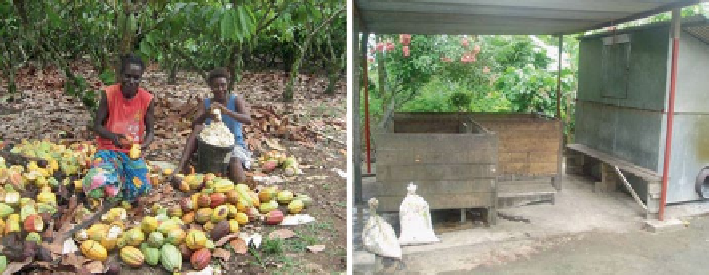Agriculture Reference
In-Depth Information
Fig. 8.17
Small cocoa growers in PNG harvesting and opening pods to ferment their beans in
small a box fermentery with a kiln drier. (©Lambert)
These precursors react later during roasting, producing the characteristic choco-
late flavour. Fermentation is a natural process caused by a microbial succession of
yeasts and acetic/lactic bacteria and is performed by cocoa growers after pod open-
ing and bean extraction (Wood and Lass
1985
). In Africa, most growers ferment
their cocoa in the field in heaps piled on, and covered by, banana leaves but in Asia/
Pacific region, cocoa is mainly fermented in wooden boxes (Fig.
8.17
).
In Sulawesi, the main cocoa producing region of Asia, growers do not ferment
their cocoa, resulting in low quality beans used mainly for extraction of cocoa but-
ter. Following 5 to 7 days of fermentation, the beans are mainly sun-dried on el-
evated platforms, a cheap method resulting in high quality (Figs.
8.18
and
8.19
).
However, in many cocoa producing countries, the cocoa harvest coincides with the
rainy season and drying can be a big challenge. Many cocoa growers use wood-
fired kiln driers (Samoan driers) but, poor maintenance of the fire chamber and flue
leads to smoke contamination.. This is a particularly a problem in the Pacific.
Cocoa trees are susceptible to a large variety of pests and diseases that are dif-
ferent on each continent. The most common disease is “black pod” (
Phytophthora
palmivora
) which causes pod rot and trunk canker. Devastating fungal diseases
in the Americas are witches' broom (
Moniliophthora perniciosa
) and moniliasis
(
Moniliophthora roreri
); in Africa,
Phytophthora megakarya;
and in Asia,
Oncoba-
sidium theobromae
causing vascular-streak dieback The only viral disease of cocoa
is the Cocoa Swollen Shoot Virus in Africa. The main insect pests are cocoa pod
borer (
Conopomorpha cramerella
) in the Asia/Pacific region and sap-sucking bugs
(mirids or capsids) in Africa.
Processing of dry, fermented cocoa is a two phase process that is normally done
by different businesses. The first step, cocoa grinding, involves roasting, deshelling,
grinding/milling of nibs into a fine cocoa paste called cocoa liquor (mass) that is the
base ingredient for chocolate. A good quality chocolate requires additional cocoa
butter which is expressed from cocoa liquor in a large hydraulic press, separating it
from the cocoa powder.

